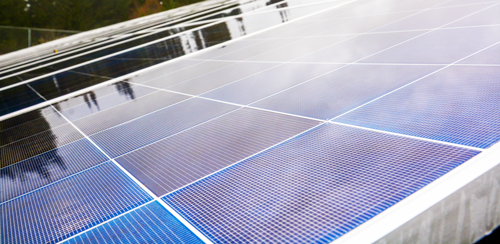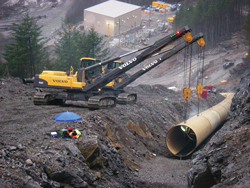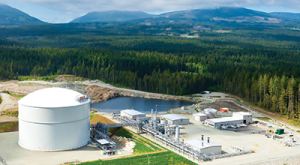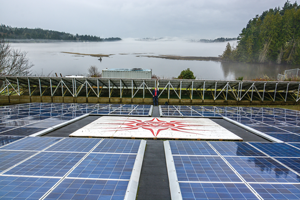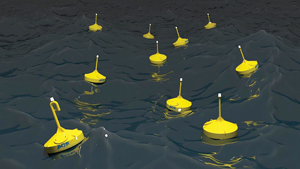Cleaner Energy Alternatives
The Option for our Nations
Many of our nations are walking the walk when it comes to long-term sustainability by making use of the sun, wind and water to produce energy.
Projects of all sizes—from tens of thousands of dollars to mega-millions—are appearing both on reserve lands and in traditional territories, utilizing run-of-river hydro, solar, tides and wind.
At the Tsleil-Waututh community daycare, a solar tracker provides all the electricity for the building while serving as a ‘living’ next-door classroom.
On a much grander scale, at T’Sou-ke, large solar arrays on buildings’ roofs—from the canoe shed to homes—generate power back into the BC Hydro grid and provide hot water for many families.
Further north on Vancouver Island, Stz’uminus nation and Cowichan Tribes have part-ownership in a huge Fortis BC natural gas storage facility.
Klahoose First Nation is reaping the benefits of the massive run-of-river hydro projects in its territory around Toba Inlet. Sliammon and Homalco nations, along with Klahoose, are seeing jobs along with revenue. And Homalco is in talks about similar projects in Bute Inlet.
Then there are the wind power projects involving T’Sou-ke and Tsleil-Waututh nations, not to mention the T’Sou-ke partnership to generate electricity from the tides in Sooke Basin.
Hydro Projects on Traditional Lands
Plutonic Power Corp. and GE Energy Financial Services announced the East Toba-Montrose run-of-river hydroelectric project about ten years ago. Few realized the impact it would have on Klahoose nation, based at T’oq (Squirrel Cover) on Cortes Island.
With major work happening in Klahoose territory, Sliammon signed a revenue agreement for the 155 kms of transmission lines that would cross its lands. Homalco also started talks with the company about Bute Inlet projects that would be part of a Green Power Corridor.
Meanwhile workers from the three nations were finding steady, well-paid work. When the Toba-Montrose project went on-line in 2010, planning was underway for the Jimmie Creek project. At 62 megawatts, it is about one-quarter the size of the one on Toba and is slated for operation in 2016.
Unique Ownership Model is a Gas!
The 2012 limited partnership between FortisBC and Stz’uminus and Cowichan Tribes in the $200
million liquefied gas storage facility meant a $5.7 million investment by each nation with long-term revenues.
Work began in 2008 with Stz’uminus getting about $4.6 million in contract work including site preparation, road construction and power line installation. Youth took part in a utility construction program, with some graduates securing employment with local subcontractors.
The two nations, along with FortisBC, will each receive a regulated rate of return on equity, as approved by the BC Utilities Commission. They also have representation on the partnership’s board of directors.
“Our investment in the liquefied natural gas facility will create economic prosperity and benefits for our community’s future,” said Chief John Elliott of Stz’uminus.
Sun Shines in More Ways than One
When the solar panels went up at T’Sou-ke in 2009, it marked a new direction. Those panels generate electricity and hot water. They also produce scores of visitors from around the world wanting to know more about the sustainability model that Chief Gordon Planes loves to talk about.
“Power is power,” the chief said. “To have control over your own electrical power through the elements, the sun and wind, puts you in a very powerful position in society.”
“What’s the most important thing to us?” the chief asked. “It is simple and it’s easy. That’s the way you have to look at it, in a simple way, and that is taking care of Mother Earth. It’s not just the solar. It’s the connection to our traditional territory, the clean water, having a healthy environment with the animals and also our medicines and our old way of life and our cedar.
“It is appropriate that First Nations take the lead in demonstrating how to live without fossil fuels once again.”
Those Tides Rise and Fall
The T’Sou-ke Ocean Energy Limited Partnership (TOE) was announced earlier this year between the nation and Sooke-based firm Accumulated Ocean Energy Inc.
Accumulated Ocean Energy Inc. is building systems for ocean wave energy production. Arrays of buoys off the shores of the T’Sou-ke traditional territory have tested how to efficiently transform wave energy into highly-compressed air.
The air travels through hoses to onshore reservoirs for storage and subsequent use to power machinery producing electricity, hydrogen gas, potable water and aeration for aquaculture.
TOE intends to begin manufacturing immediately and hopes to drive aboriginal jobs, training and education in the technology. The goal is to not only produce wave energy but also see this sustainable energy source bring highly-skilled, well-compensated employment.


